Draco Volans Lizard
Draco volans
Beneath the lizard’s “wings” are a pair of enlarged ribs for support.
Advertisement
Draco Volans Lizard Scientific Classification
- Kingdom
- Animalia
- Phylum
- Chordata
- Class
- Reptilia
- Order
- Squamata
- Family
- Agamidae
- Genus
- Draco
- Scientific Name
- Draco volans
Read our Complete Guide to Classification of Animals.
Draco Volans Lizard Conservation Status
Draco Volans Lizard Facts
- Prey
- Insects, especially ants and termites
- Name Of Young
- Hatchling
- Group Behavior
- Solitary
- Fun Fact
- Beneath the lizard’s “wings” are a pair of enlarged ribs for support.
- Estimated Population Size
- Unknown but conservation status is Least Concern.
- Biggest Threat
- Predators such as birds of prey, larger reptiles, pet trade
- Most Distinctive Feature
- Its “wings,” a patagium spread supported by ribs
- Other Name(s)
- Flying lizard, gliding lizard
- Gestation Period
- Eggs hatch in 32 days
- Litter Size
- Five
- Habitat
- Second growth forest
- Predators
- Birds of prey, larger lizards, tree snakes
- Diet
- Carnivore
- Type
- Reptile
- Common Name
- Common flying dragon
- Location
- Southeast Asia, south India, Philippines
View all of the Draco Volans Lizard images!
Draco Volans is known as “The Flying Lizard” or “The Gliding Lizard. ”
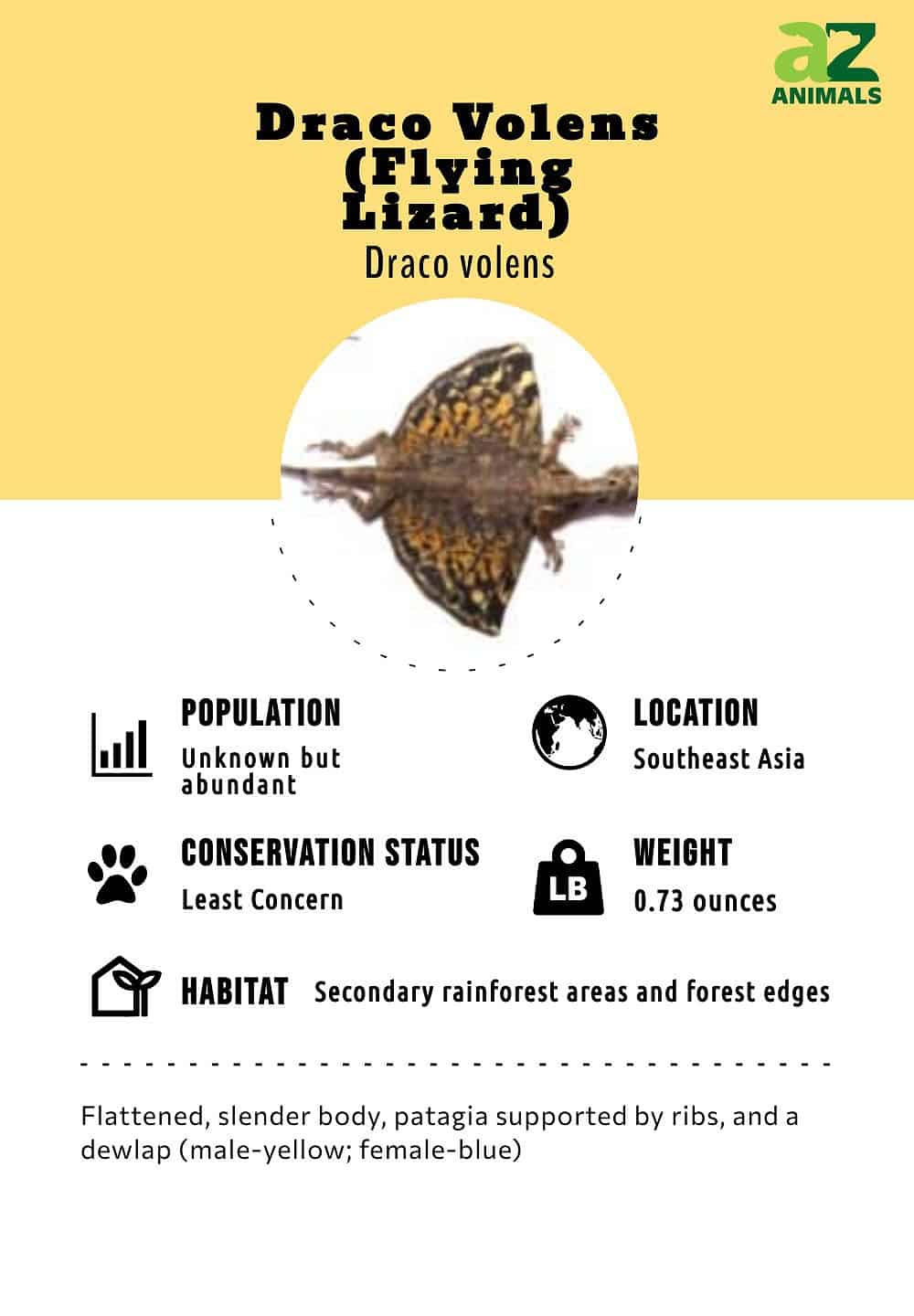
This lizard is known by its scientific name of Draco Volens, but it is often called the common flying dragon. Although volans means “flying,” this lizard doesn’t really fly but glides. It uses patagia, membranes that are attached to its ribs, to glide from place to place. It is found in rainforests where it can move easily from one tree to another.
See all of our expert product reviews.
Four Incredible Facts:
- Besides its beauty and gliding ability, one reason the flying dragon’s population is so robust is that people think it’s venomous and won’t eat it. It’s not venomous at all.
- This lizard apparently knows how to read a clock and believes in siestas. It’s active between 8:00 and 11:00 in the morning then takes a break until 1:00 p.m.
- Draco volans can glide for about 26 feet, on average.
- It is the only gliding animal whose patagia are supported by its ribs. In other animals, the patagium is simply a membrane of skin attached to the limbs.
Scientific Name
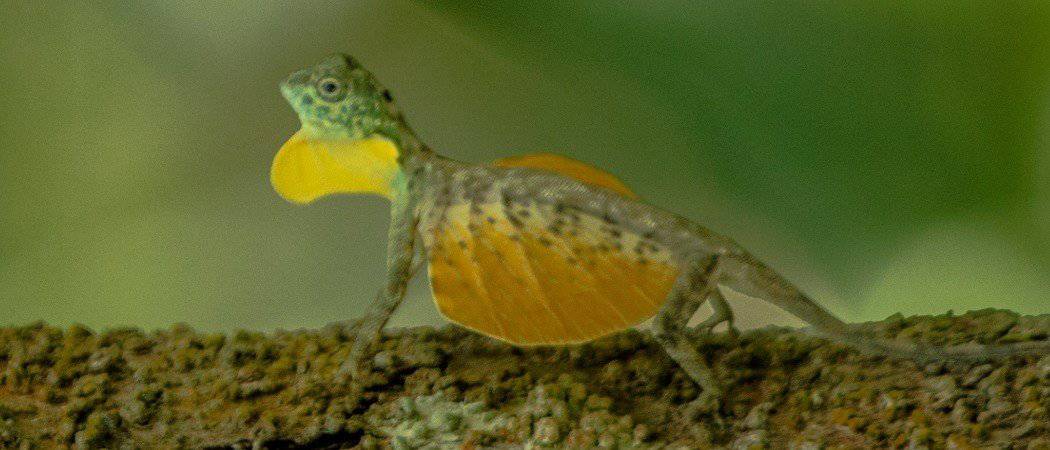
The Draco volans lizard belongs to the family Agamidae and is one of about 45 similar species.
©iStock.com/Jiri Hrebicek
The Draco volens belongs to the family Agamidae and the genus Draco. Draco volans, means “flying dragon” in Latin. There are about 45 other species in the Draco genus. They include:
- Draco abbreviatus
- Draco blanfordii
- Draco boschmai
- Draco cristatellus
- Draco dussumieri
- Draco formosus
- Draco indochinensis
- Draco iskandari
- Draco maximus
- Draco melanopogon
- Draco modiglianii
- Draco ornatus
- Draco quinquefasciatus
- Draco reticulatus
- Draco spilopterus
- Draco taeniopterus
- Draco walkeri
Draco, or flying, lizards, evolved away from their non-flying or non-gliding relatives as much as 60 million years ago.
Appearance
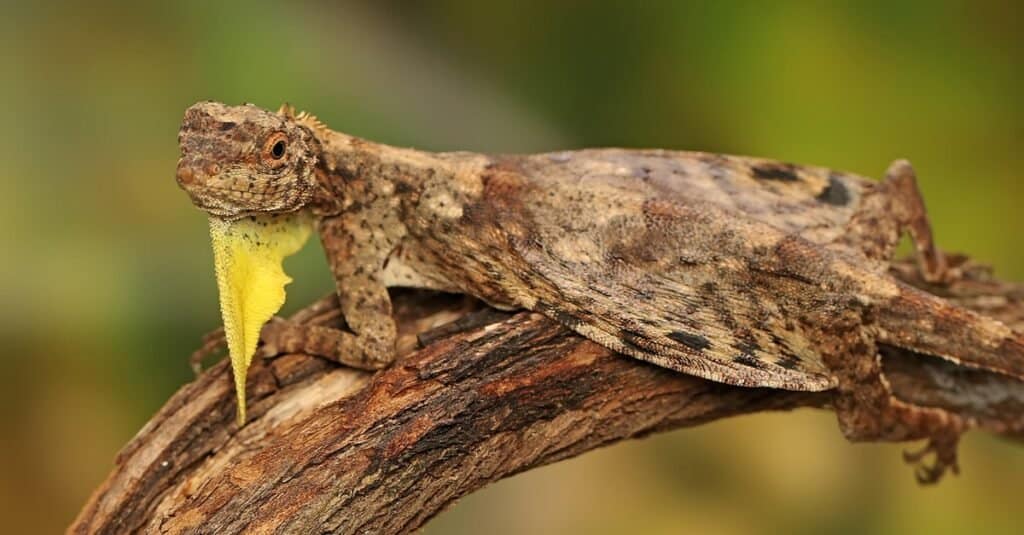
is slightly smaller and weighs less than the female.
Health and Entertainment for your Draco Volans Lizard
See all of our expert product reviews.
©I Wayan Sumatika/Shutterstock.com
Draco volans is a little reptile, with males being about 7.7 inches long, including their tail, and females about 8.35 inches long. The weight of the animal is about 0.73 ounces on average, with the weight of the male less than that of the female. The flattened, slender body is notable for the large “wings” that are used for gliding, supported by sets of elongated ribs. Besides these wings or patagia, both males and females have a bit of skin under their heads known as a dewlap. The dewlap is used to both guide the animal’s flight and for display. The male’s dewlap is brilliant yellow, while the female’s is smaller and a sort of cadet blue.
The patagia are notable because they differentiate Draco volans from other types of flying lizards. They have rows of tiny brown rectangles on the top and black dots on the bottom. The wings of the male have blue tinges, while the female’s wings have yellow tinges, which you can see when the wings are spread.
Behavior
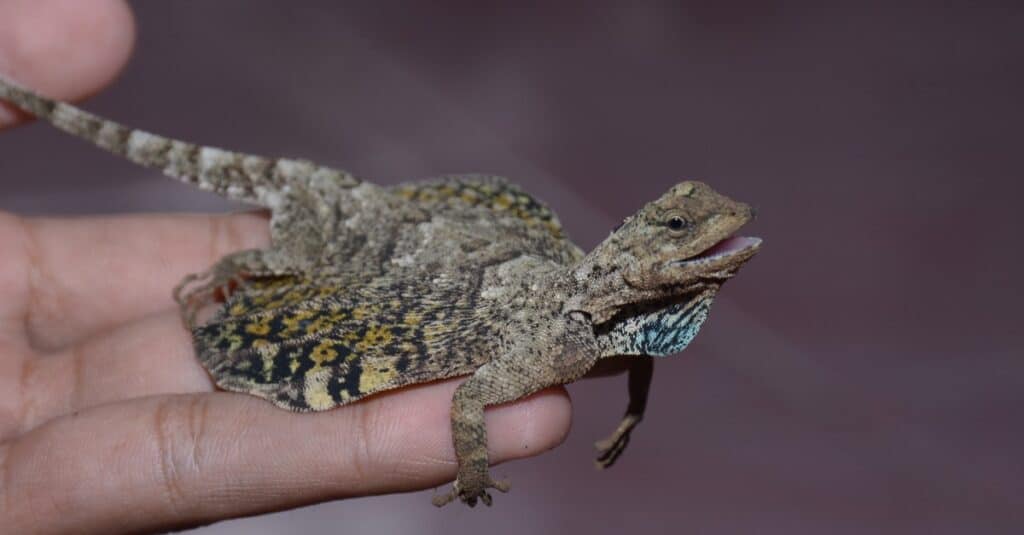
A female Draco volans will leave her residential tree only to lay eggs, while males spend their lives in the trees.
©alfian bhatok/Shutterstock.com
Draco volans is mostly solitary, and the males are very territorial. They will claim two or three trees and try to deter any other males that trespass. At the same time, the trees are home to a handful of females.
The lizard is active during the day, especially in the morning. Then, it takes a break between about eleven o’clock in the morning and one o’clock in the afternoon. Draco volans doesn’t know, of course, that these hours are when humans break for lunch or a nap. Their behavior is probably a reaction to the sun being a bit too hot at that time of day.
Male lizards basically spend their entire lives in the trees, while females leave the trees only to lay eggs. It is from their perch on a tree that this lizard can spread out its patagia and glide to another tree. It splays out its limbs, extends its dewlap, and uses its tail to steer. Draco volans glides only to get from one place to another and not to avoid its many predators. To escape predators, the lizard simply climbs quickly out of the way. The lizard also doesn’t glide during bad weather.
A lizard that encounters another of its species will either partially or fully extend its dewlap and wings or bob its entire body up and down. If a male encounters a female, he’ll display and circle around her.
Habitat
Draco volans lives in the tropical rain forests of southeast Asia, from southern India to Borneo and the Philippines. Specifically, it prefers the more open areas of early second-growth forests and on forest edges.
Some people keep these little lizards as a pet, though they are tricky to care for, especially for a beginner. Flying lizards are skittish and need a huge enclosure full of vegetation and even small trees. Indeed, there are places where it is illegal to own one of these skittish lizards. Even zoos find it challenging to take proper care of a flying lizard.
Diet
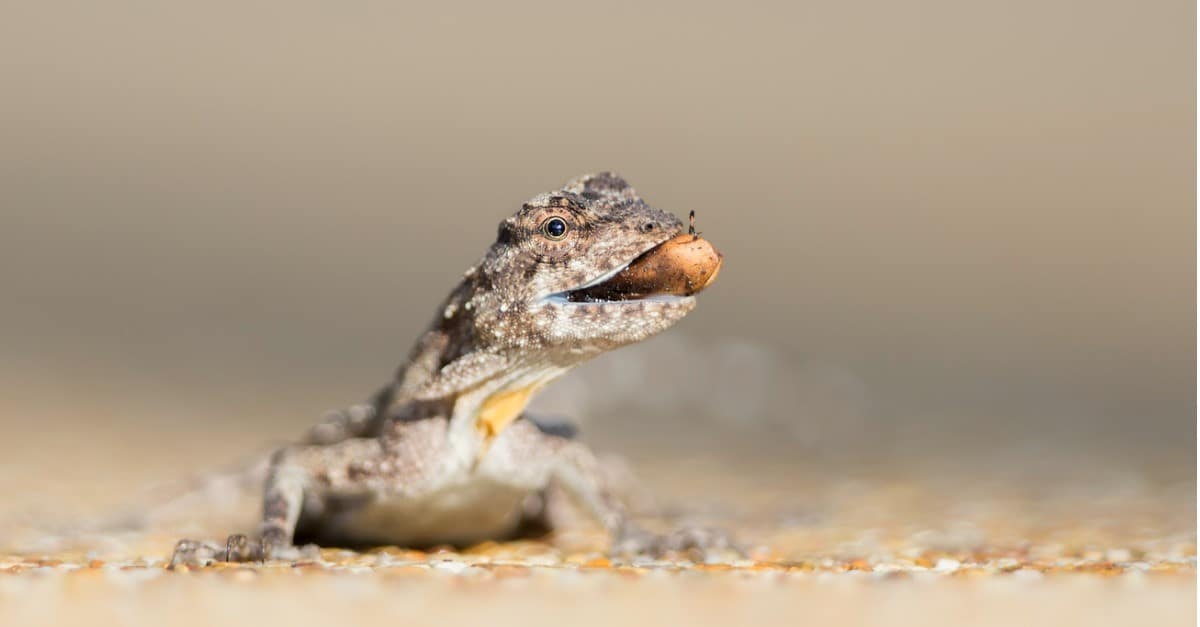
A rare moment for a delicate gliding lizard, Draco volans, as it forages for food at ground level.
©iStock.com/KristianBell
In the wild, Draco volans eats only termites and ants. Some eat only ants. Generally, it doesn’t search for these insects but sits on a tree trunk or limb and waits for them to appear. Then, it will simply snap them up. On rare occasions, a flying dragon may forage for food at ground level.
Predators and Threats
Since it is a small animal, Draco volans is a meal for a variety of larger animals, including birds, snakes, and other reptiles, including lizards. Although it doesn’t appear to glide to escape these predators, it is very fast. Its coloration also allows it to blend in among the branches and leaves of the trees where it lives. It is not hunted by people for food, but it is sometimes collected for the pet trade.
Reproduction and Life Cycle
Although biologists don’t appear to know when Draco volans is sexually mature, they know that the lizards mate in the winter, when the weather is warm but not scorching hot, and the wet monsoon has arrived. The male lizard claims a territory of two or three trees, and these trees have resident females. The male displays to the female and circles her three times before they mate, but if she’s not interested, she will display back at him with her wings and her dewlap.
If they do mate, she will leave the tree for the ground. She’ll nudge her head into the soil to create a nest, lay five eggs inside of it, then cover them up with more soil. She’ll guard the eggs for about 24 hours but no longer. Then, she’ll leave, and the eggs will receive no further care. They hatch in a little over a month. The lizards have a lifespan of about eight years.
Population
The IUCN has given the Draco Valens a conservation status of least concern because it is still abundanat in its habitat.
View all 110 animals that start with DThank you for reading! Have some feedback for us? Contact the AZ Animals editorial team.
Sources
- Integrated Taxonomic Information System, Available here: https://www.itis.gov/servlet/SingleRpt/SingleRpt?search_topic=TSN&search_value=1055569#null
- Amino Apps, Available here: https://aminoapps.com/c/reptiles/page/item/draco-lizard-draco-volans/wKb6_b2MHpIJe7WWL8Xj5xxvePmZkD4w7rj
- PetHelpful, Available here: https://pethelpful.com/exotic-pets/Lizards-that-look-like-dragons
- Oxford Academic Integrative & Comparative Biology, Available here: https://academic.oup.com/icb/article/51/6/983/616030
- Blue Planet Biomes, Available here: https://www.blueplanetbiomes.org/rainforest_climate.php

















